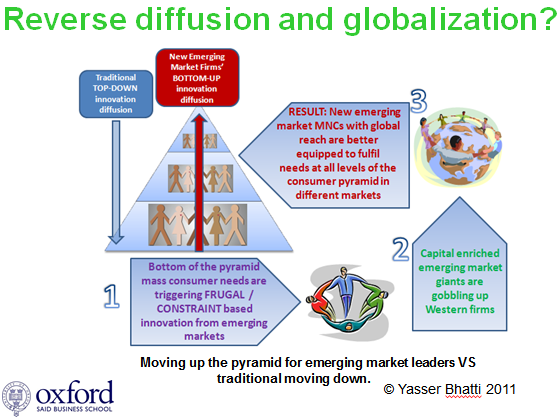Frugal-Reverse-Cost-BOP Innovation
CEO of GE Jeff Immelt calls the frugal innovation phenomenon reverse innovation. “If GE doesn’t master reverse (frugal) innovation, the emerging giants could destroy the company” (Immelt, Govindarajan, and Timble, 2009). Although there are several dimensions to frugal innovation, the overarching theme is simplification in process and outcome. There can be many connotations for “reverse” which are similar to frugal innovation in both process and outcome.
One, frugal or reverse innovation integrates specific needs of the bottom of the pyramid markets as a starting point and works backward to develop appropriate solutions which may be significantly different from existing solutions designed to address needs of upmarket segments (Silicon India, 2010). The context in which this innovation is seen occuring in lies in developing markets. Fu, Soete & Sonne (2010) claim that the innovation process itself is now likely to be reversed, starting with the design phase which will, to a large extent, be concerned with finding functional solutions for some of the particular BoP users’ framework conditions… (such as) a clear adaptation to the often poor local infrastructure facilities with respect to energy delivery systems, water access, transport infrastructure, digital access.
Two, there is a reverse process of diffusion among consumers. Innovation is often perceived in the developed world as technological revolutionary products tried and tested by innovators and early adopters (Rogers, 1962). Trendy and expensive products are accepted by the top of the pyramid first which then get trickled down to the masses or early and late majority consumers. Professional groups in the highest income bracket in society that constitute the “tip” of the income pyramid act as the early adopters and the first try-out group, contributing to the innovation monopoly rents of the innovating firm. But this “professional-use driven” innovation circle has been the main source for extracting innovation rents out of consumer goods that was considered “too long” (Fu et al, 2010). Hence, in frugal innovation we see a challenge to this notion of diffusion from the top to the bottom. Frugal innovation “reverses” the process of diffusion by targetting the early and late majority consumers and relies on profiting not from monopoly rents, but rather economies of scale rents. Eventually, all segments of the market benefit from the innovation. A prime example of this is mobile phone banking by Telenor in Pakistan and MPesa in Kenya wherein success has in these business models have been marked through adoption by rural BOP consumers before becoming popular in all segments rural and urban.
Three, we might see a trend in practices of innovation being adopted from the East to the West wherein Western practices had dominated thus far. Innovation is no longer formulated just in the West and exported to the developing world. Instead, many new innovations that are considered “frugal” will emanate from the emerging world and into the West (The Economist, 2010). Again, mobile phone banking and inexpensive and portable medical devices are emanating from emerging / developing markets but could find their way to mature markets.
I believe frugal holistically describes the phenomenon more aptly. Reverse innovation, to me, is based on a primary characteristic of the phenomenon which is bottom-up and East-to-West. Others have called this phenomenon “Cost” innovation (Li and Hang, 2010) and “BOP” innovation (Prahalad, 2005) which limits the definition to simply reduction in cost of outcome for a specific target market. Instead, frugal innovation embodies the frame of mind, philosophy, process, and purpose behind this phenomenon spanning from exploration to exploitation phases. More on this later!


Interesting Post. You kind of put a perspective that shows the link between frugal, reverse and disruptive innovation from the BOP.
A tip: Include possibility to share your posts via twitter, facebook …